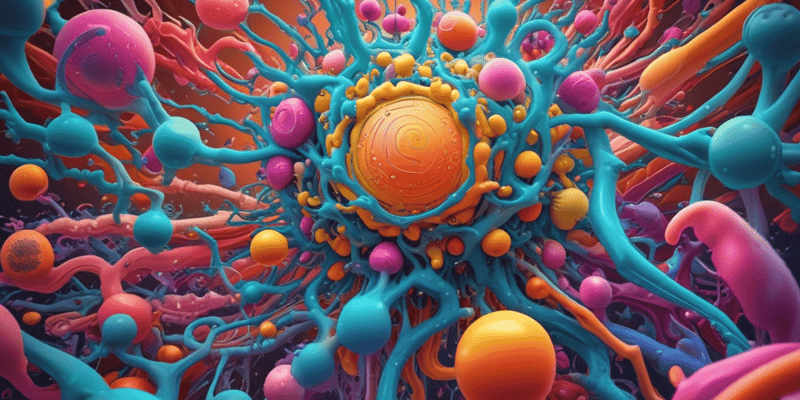30 Questions
What is the function of integral proteins in the cell membrane?
Form structural channels for water-soluble substances to diffuse
Which statement accurately describes the role of peripheral proteins in the cell membrane?
Function primarily as enzymes or controllers of transport through pores
What is the primary function of membrane carbohydrates in the cell?
Help repel negatively charged substances due to negative surface charge
Which statement accurately reflects the lipid layer of the cell membrane?
Impermeable to water-soluble substances like glucose and ions
What is the main function of glycoproteins in the cell membrane?
Serve as receptors for binding hormones
How do carrier proteins differ from integral proteins in their function?
Transport substances against their electrochemical gradients
What type of substances can easily pass through the lipid core of the bilayer?
Lipophilic substances
How does cholesterol contribute to the lipid bilayer's impermeability to small water-soluble molecules?
By inserting itself between hydrophilic heads of phospholipids
What is the main role of structural proteins in the cell membrane?
Creating cell junctions that hold tissues together
Which type of membrane proteins change conformation to form open channels for substance transport?
Integral proteins
Which function of sphingolipids protects cells from harmful environmental factors?
Serve as adhesion sites for extracellular proteins
How do hydrophilic substances interact with the hydrophobic interior of the lipid bilayer?
They are repelled by the hydrophobic interior
In the context of membrane proteins, which type of proteins are involved in signal transfer processes and can open and close?
Membrane receptors
Which ions are mentioned as being able to pass through the lipid bilayer?
Na+ and Ca++
What type of transport mechanism moves substances across a membrane from an area of high concentration to low concentration without using energy?
Facilitated diffusion
Which factor does NOT influence the rate of diffusion during facilitated diffusion through a membrane?
Concentration gradient
What type of cell transport system describes the movement of substances into or out of the cell without using energy?
Passive transport
Which type of proteins are categorized based on their location in the membrane rather than their catalytic activity or role in signal transfer?
Membrane transporters
What distinguishes protein channels mentioned in the text?
They are selectively permeable to certain substances
How are voltage-gated channels controlled?
By responding to the electrical potential across the cell membrane
What is a characteristic of ligand-gated channels?
They open or close by chemicals binding to channel proteins
What is the primary energy source for endocytosis?
ATP
How does receptor-mediated endocytosis differ from other types of endocytosis?
Molecules bind to specific receptors in receptor-mediated endocytosis
What characterizes bulk transport via endocytosis?
Transported molecules are too large for transport proteins
What is the main difference between simple diffusion and facilitated diffusion?
Facilitated diffusion involves the movement of molecules through a lipid bilayer, while simple diffusion does not.
What is the primary requirement for primary active transport?
Creation of a concentration gradient
How does pinocytosis differ from phagocytosis?
Phagocytosis occurs through receptors, while pinocytosis does not require receptor binding.
What is opsonization in the context of phagocytosis?
Attachment of antibodies to phagocyte receptors to enhance particle engulfment
How does secondary active transport differ from primary active transport?
Primary active transport relies on energy directly from ATP, while secondary active transport uses a pre-existing concentration gradient.
What initiates Phagocytosis in cells?
Specific antibodies binding to receptors on the phagocyte surface
Study Notes
Cell Membrane Structure and Function
- Integral proteins span the cell membrane, interacting with both lipid and aqueous environments.
- Peripheral proteins bind to the surface of the cell membrane, often involved in cell signaling and attachment.
Cell Membrane Components
- Membrane carbohydrates (glycoproteins, glycolipids) play a role in cell-cell recognition, signaling, and adhesion.
- The lipid layer of the cell membrane is semi-permeable, allowing certain substances to pass through, such as oxygen, carbon dioxide, and small non-polar molecules.
- Cholesterol contributes to the lipid bilayer's impermeability to small water-soluble molecules by filling gaps between phospholipid tails.
Protein Functions in the Cell Membrane
- Glycoproteins play a role in cell-cell recognition, signaling, and adhesion.
- Carrier proteins transport substances across the cell membrane, whereas integral proteins span the membrane, interacting with both lipid and aqueous environments.
- Channel proteins change conformation to form open channels for substance transport.
- Structural proteins provide support and maintain the cell membrane's shape.
Lipid Bilayer Permeability
- Small non-polar molecules, such as oxygen and carbon dioxide, can easily pass through the lipid core of the bilayer.
- Hydrophilic substances cannot directly interact with the hydrophobic interior of the lipid bilayer.
Cell Transport Mechanisms
- Facilitated diffusion moves substances across a membrane from an area of high concentration to low concentration without using energy.
- Passive transport occurs through simple diffusion or facilitated diffusion.
- Primary active transport uses energy to move substances against their concentration gradient.
- Secondary active transport uses the energy from another transport process to move substances against their concentration gradient.
Endocytosis and Phagocytosis
- Endocytosis involves the movement of substances into the cell without using energy.
- Receptor-mediated endocytosis involves specific binding of substances to receptors, leading to internalization.
- Bulk transport via endocytosis involves the uptake of large quantities of substances.
- Phagocytosis is a type of endocytosis where large particles or cells are engulfed.
- Opsonization is a process where proteins bind to particles, marking them for phagocytosis.
Mechanisms of Cell Transport
- Voltage-gated channels open or close in response to changes in membrane potential.
- Ligand-gated channels open in response to binding of specific molecules (ligands).
- Primary active transport requires energy from ATP hydrolysis.
- Secondary active transport uses energy from another transport process.
Test your knowledge of integral and peripheral proteins, their functions, and the role membrane carbohydrates play in cell membranes. Explore the different types of proteins present in cell membranes and their specific functions.
Make Your Own Quizzes and Flashcards
Convert your notes into interactive study material.
Get started for free



